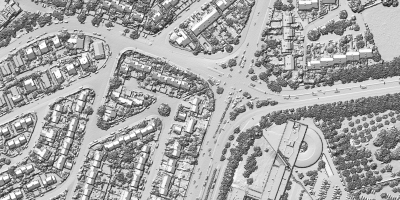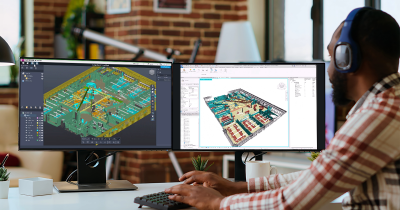In this blog post, which originally appeared on the Stockpile Reports blog, solutions delivery consultant Jonathan Stephens digs into unexpected–but very compelling–reason why the latest generation of iPhones are the best smartphones for 3D capture. He covers the innovation from the angle of stockpile measurement, but the argument applies to most smartphone photogrammetric capture applications.
Apple just released their new flagship iPhone XS and XS Max on September 21st. The phone looks nearly identical to last year’s iPhone X, however, under the hood it is a completely different story. We spent the past couple months visiting rock quarries, bark mulch producers, and paper mills testing the new iPhone and here is why we love the new iPhone XS.
The camera of the future
Apple’s iPhone XS keynote spent a considerable amount of time explaining why the new camera is far better than any camera they have produced in the past. Usually, the improvements are incremental and not worth spending hundreds of dollars each year to upgrade. We are excited to say for the first time in a while that this camera is worth the money.
What is different this time with the camera? Extended dynamic range! Broken down in simple terms, this means the camera can see more detail in the brightest and darkest sections of the images it captures. Apple accomplishes this through impressive real time computation only possible on their new A12 Bionic chipset. Instead of using the traditional video capture method of capturing 30 images per second, the iPhone captures 60 images per second alternating light and dark images. The light and dark image pairs are merged together in real time to extend the dynamic range in the video:

iPhone dynamic range comparison
The picture above highlights the extended dynamic range on the iPhone XS Max. The area around the sun on iPhone 6S video is completely white and blown out. Cloud and sky detail around the sun is still visible in the iPhone XS Max video. The stockpile surface detail on the iPhone XS Max is visible even on the darkest sections of the image. However, dark areas in the iPhone 6S video are almost completely black.
Why does this matter to you?
Your stockpile measurement videos on the iPhone XS now look fantastic, what exactly does that mean? As we head into winter, the new iPhone will be a game changer for harsh sun conditions. In the following article we will explain why the extended dynamic range on the iPhone XS means capturing measurements with the sun on the horizon will get a lot easier, failure rates due to sun-flare are greatly reduced, and accuracy of volumes is increased due to the greater detail in dark parts of the pile.
Capturing Measurements Gets a Lot Easier
You all have been there: it is 8:30 in the morning and you are trying to measure stockpiles while the sun is in your eyes. You try advanced measurement techniques such as holding a clipboard over your iPhone in an attempt to reduce the amount of sun the camera is capturing. Angling the camera away from the sun is also a technique of the past. Sometimes these advanced techniques work, sometimes they don’t. The iPhone XS cuts out the need for any advanced measurement techniques. Extended dynamic range means that the sun doesn’t flare across the camera lens and lead to an unusable video. Using the iPhone XS, you can measure inventory piles in the morning and late afternoon the same way that you would midday. Say goodbye to any fancy camera angling or trying to hide the sun with your hand.
No More Failed Measurements
Photogrammetry is the engine that powers the ability to be able to measure a stockpile by taking a simple iPhone video. In order to measure a stockpile successfully, we need continuous, clear video footage from the iPhone camera. Sun flare from the sun low on the horizon cuts through imagery like a knife obscuring a part of the scene. We show both the iPhone 6S and iPhone XS footage from a measurement of the same pile in the below image. The colorful streaks on the imagery illustrate unique surface features being tracked as the camera moves around the pile. On the top right, you can clearly see that the sun flare cuts through the scene causing a gap in the streaks. This gap in features being tracked causes a gap in the final measurement data. The data gap is what causes iPhone measurements to fail due to sun flare.

Sun flaring on the iPhone 6S video caused the measurement to fail. The iPhone XS video exhibited no flare.
The bottom right photo from the iPhone XS can handle the bright sun and no sun flare is present in the imagery. The camera is able to measure the complete surface of the pile. We tested against sun flare on numerous piles and we concluded that sun flare is almost non-existent with the iPhone XS. This is important to users who are measuring critical month end piles and cannot afford to have a failure.
Accuracy of volumes in dark areas increased
An unexpected benefit of the new iPhone XS is that the camera captured previously unseen details in dark shadowy areas of a stockpile. The dark shadows cast over stockpiles due to a low sun angle in the sky or due to poor lighting situations in buildings meant that some areas of the piles were obscured in darkness. The extended dynamic range of the iPhone XS camera effectively lets the iPhone see areas that would be completely dark in the past. The pair of photos below shows an image from a measurement in a poorly lit building. The photo on the left is the raw imagery from the camera. On the photo on the right, we boosted the brightness of the image to reveal that the surface details were still captured. Brightening a dark image captured with a previous generation iPhone would reveal that the camera did not capture any surface detail.

The increased amount of detail captured on piles in dark settings provides us with more information and more accurate volumes. We no longer need to estimate the surfaces in the dark areas of a stockpile. This increase in accuracy is great news for site managers, accountants, and auditors. They have greater confidence that an entire pile is being measured correctly.
Should I upgrade My iPhone?
We admit that the new iPhone is more expensive than any iPhone in the past. The new iPhone XR starts at $750 and you can price the iPhone Max up to $1,500. This leaves most people wondering if it is worth the expense to upgrade. Ask these simple questions before deciding to upgrade:
- Do I need to measure stockpiles early in the morning or late in the afternoon?
- Have I missed critical stockpile measurements in the past due to sun issues?
- Do I need to train new users to measure Stockpiles in the near future?
- Do I have stockpiles indoors with poor lighting?
If you answer yes to any of these questions, we highly recommend upgrading. You will no longer have to consider the time of day when measuring stockpiles because the dynamic range of the camera can handle all types of lighting. Missed measurements due to sun flare issues will be virtually eliminated with the iPhone XS. Training new users will be easier and you can skip the frustration of having to reteach complicated advanced measurement techniques. Lastly, measuring in poor lit situations will still yield great results.

Note: The iPhone XS Max was used for all testing. The iPhone XR and XS will produce the same results.










